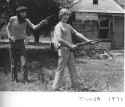
Larry Clark is one of the most important names in the history of photography. His first project, published as the well-known photo book Tulsa (1971), was groundbreaking with its raw, grainy images depicting the life of young Americans on the edge of society.
The pictures, taken during Clark’s youth in Tulsa, Oklahoma, balance on the precipice between documentary, the voyeuristic and the confessional. With a number of other photographers and filmmakers, including Nan Goldin and Gus Van Sant, who, like Clark, used the camera as a means of survival, his work formed a school. His focus has always been on documenting subcultures such as surfers, punks or skateboarders. To give the images authenticity he needs to understand and be part of the culture he depicts.
Clark’s mother worked as a baby photographer and from the age of 13 he was her assistant. He then went on to study photography for two years. However, Clark was not a photographer searching for a documentary project; he simply documented the life he himself was living in Tulsa in the 1960s and 70s. He first became dependent on drugs when he was 16 and over a period of seven years he immortalized, sometimes with unbearable honesty, a life filled with parties, drugs, sex, crime and violence. It was a teenage culture that failed to match the contemporary image of The Young Americans.

